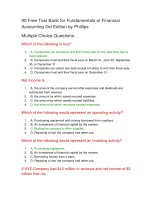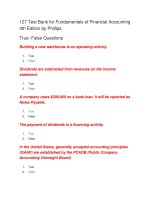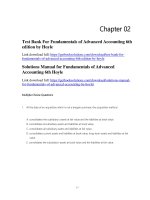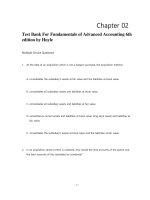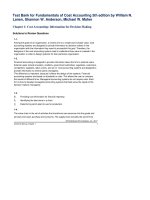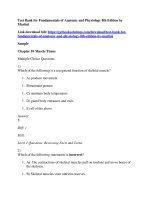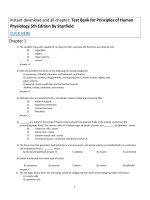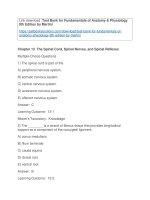Test bank for fundamentals of anatomy physiology 9th edition by martini
Bạn đang xem bản rút gọn của tài liệu. Xem và tải ngay bản đầy đủ của tài liệu tại đây (365.74 KB, 40 trang )
Link download :Test Bank for Fundamentals of Anatomy & Physiology
9th Edition by Martini
/>
Chapter 13 The Spinal Cord, Spinal Nerves, and Spinal Reflexes
Multiple-Choice Questions
1) The spinal cord is part of the
A) peripheral nervous system.
B) somatic nervous system.
C) central nervous system.
D) autonomic nervous system.
E) afferent nervous system.
Answer: C
Learning Outcome: 13-1
Bloom’s Taxonomy: Knowledge
2) The ________ is a strand of fibrous tissue that provides longitudinal
support as a component of the coccygeal ligament.
A) conus medullaris
B) filum terminale
C) cauda equina
D) dorsal root
E) ventral root
Answer: B
Learning Outcome: 13-2
Bloom’s Taxonomy: Knowledge
3) Spinal nerves are
A) purely sensory.
B) purely motor.
C) both sensory and motor.
D) interneuronal.
E) involuntary.
Answer: C
Learning Outcome: 13-2
Bloom’s Taxonomy: Knowledge
4) The spinal cord consists of five regions and ________ segments.
A) 5
B) 12
C) 25
D) 31
E) The number varies widely among individuals.
Answer: D
Learning Outcome: 13-2
Bloom’s Taxonomy: Knowledge
5) The dorsal root ganglia mainly contain
A) axons of motor neurons.
B) axons of sensory neurons.
C) cell bodies of motor neurons.
D) cell bodies of sensory neurons.
E) synapses.
Answer: D
Learning Outcome: 13-2
Bloom’s Taxonomy: Knowledge
6) The dorsal root of a spinal nerve contains
A) axons of motor neurons.
B) axons of sensory neurons.
C) cell bodies of motor neurons.
D) cell bodies of sensory neurons.
E) interneurons.
Answer: B
Learning Outcome: 13-2
Bloom’s Taxonomy: Knowledge
7) The ventral root of a spinal nerve contains
A) axons of motor neurons.
B) axons of sensory neurons.
C) cell bodies of motor neurons.
D) cell bodies of sensory neurons.
E) interneurons.
Answer: A
Learning Outcome: 13-2
Bloom’s Taxonomy: Knowledge
8) The tough, fibrous, outermost covering of the spinal cord is the
A) arachnoid.
B) pia mater.
C) dura mater.
D) epidural block.
E) periosteum.
Answer: C
Learning Outcome: 13-2
Bloom’s Taxonomy: Knowledge
9) After age ________ the vertebral column continues to elongate, but the
spinal cord itself does not.
A) 8
B) 12
C) 18
D) 4
E) 1
Answer: D
Learning Outcome: 13-2
Bloom’s Taxonomy: Knowledge
10) If the dorsal root of a spinal nerve is severed,
A) output to skeletal muscles would be blocked.
B) output to visceral organs would be blocked.
C) the spinal cord would not be able to process information at that level.
D) the brain would not be able to communicate with that level of the spinal
cord.
E) sensory input would be blocked.
Answer: E
Learning Outcome: 13-2
Bloom’s Taxonomy: Comprehension
11) The subdural space lies between
A) the arachnoid mater and the pia mater.
B) the pia mater and the dura mater.
C) the dura mater and the arachnoid mater.
D) the pia mater and the subarachnoid space.
E) the endosteum and the periosteum.
Answer: C
Learning Outcome: 13-2
Bloom’s Taxonomy: Comprehension
12) The layer of the meninges in direct contact with the spinal cord is the
A) dura mater.
B) subarachnoid space.
C) arachnoid.
D) pia mater.
E) choroid plexus.
Answer: D
Learning Outcome: 13-2
Bloom’s Taxonomy: Knowledge
13) A dorsal and ventral root of each spinal segment unite to form a
A) cervical enlargement.
B) lumbar enlargement.
C) spinal nerve.
D) spinal meninx.
E) spinal ganglion.
Answer: C
Learning Outcome: 13-2
Bloom’s Taxonomy: Knowledge
14) In meningitis,
A) inflammation of the meninges occurs.
B) bacteria can be the cause.
C) viruses can be the cause.
D) CSF flow can be disrupted.
E) All of the answers are correct.
Answer: E
Learning Outcome: 13-2
Bloom’s Taxonomy: Knowledge
15) Which of the following is true regarding an epidural block?
A) It is commonly used as a method of pain control during labor and delivery.
B) It affects only the spinal nerves in the immediate area of the injection.
C) It can provide sensory and motor anesthesia, depending on the anesthetic
selected.
D) It can provide mainly sensory anesthesia, depending on the anesthetic
selected.
E) All of the answers are correct.
Answer: E
Learning Outcome: 13-2
Bloom’s Taxonomy: Comprehension
16) Cerebrospinal fluid flows within the
A) filum terminale.
B) subarachnoid space.
C) dura mater.
D) pia mater.
E) arachnoid mater.
Answer: B
Learning Outcome: 13-2
Bloom’s Taxonomy: Comprehension
17) The spinal cord continues to elongate until about age
A) 20 years.
B) 10 years.
C) 4 years.
D) 6 months.
E) 2 months.
Answer: C
Learning Outcome: 13-2
Bloom’s Taxonomy: Knowledge
18) The specialized membranes that surround the spinal cord are termed the
A) cranial meninges.
B) cranial mater.
C) spinal meninges.
D) spinal mater.
E) epidural membranes.
Answer: C
Learning Outcome: 13-2
Bloom’s Taxonomy: Knowledge
19) Blood vessels that supply the spinal cord run along the surface of the
A) pia mater.
B) dura mater.
C) epidural space.
D) subdural space.
E) subarachnoid space.
Answer: A
Learning Outcome: 13-2
Bloom’s Taxonomy: Knowledge
20) Samples of CSF for diagnostic purposes are normally obtained by placing
the tip of a needle in the
A) dura mater.
B) arachnoid mater.
C) epidural space.
D) subarachnoid space.
E) cerebral ventricles.
Answer: D
Learning Outcome: 13-2
Bloom’s Taxonomy: Comprehension
21) In an adult, the conus medullaris is found at about
A) T6.
B) T10.
C) L1.
D) L5.
E) C1.
Answer: C
Learning Outcome: 13-2
Bloom’s Taxonomy: Comprehension
22) Bill contracts a viral disease that destroys cells in the posterior gray horns
in his spinal cord. As a result, which of the following would you expect?
A) loss of sensation in his torso
B) inability to breathe
C) problems with moving his arms
D) uncontrollable sweating of his feet
E) problems with moving his legs
Answer: A
Learning Outcome: 13-2
Bloom’s Taxonomy: Application
23) The white matter of the spinal cord is mainly
A) unmyelinated axons.
B) neuroglia.
C) Schwann cells.
D) myelinated and unmyelinated axons.
E) nodes of Ranvier.
Answer: D
Learning Outcome: 13-3
Bloom’s Taxonomy: Knowledge
24) The gray horns of the spinal cord contain mainly
A) nerve tracts.
B) columns.
C) meninges.
D) nerve cell bodies.
E) funiculi.
Answer: D
Learning Outcome: 13-3
Bloom’s Taxonomy: Knowledge
25) The posterior horns of the spinal cord contain mainly
A) sensory nuclei.
B) somatic motor nuclei.
C) autonomic motor nuclei.
D) nerve tracts.
E) sympathetic nuclei.
Answer: A
Learning Outcome: 13-3
Bloom’s Taxonomy: Comprehension
26) The anterior horns of the spinal cord contain mainly
A) sensory nuclei.
B) somatic motor nuclei.
C) autonomic motor nuclei.
D) nerve tracts.
E) sympathetic nuclei.
Answer: B
Learning Outcome: 13-3
Bloom’s Taxonomy: Comprehension
27) Nerve tracts or fasciculi make up the
A) central canal.
B) posterior gray horns.
C) gray commissures.
D) white columns.
E) anterior gray horns.
Answer: D
Learning Outcome: 13-3
Bloom’s Taxonomy: Knowledge
28) In the spinal cord, white matter is separated into ascending and
descending tracts organized as
A) nuclei.
B) ganglia.
C) columns.
D) nerves.
E) horns.
Answer: C
Learning Outcome: 13-3
Bloom’s Taxonomy: Knowledge
29) The outward projections from the central gray matter of the spinal cord are
called
A) wings.
B) horns.
C) pyramids.
D) fibers.
E) tracts.
Answer: B
Learning Outcome: 13-3
Bloom’s Taxonomy: Knowledge
30) Axons crossing from one side of the spinal cord to the other within the
gray matter are found in the
A) anterior gray horns.
B) lateral gray horns.
C) posterior gray horns.
D) gray commissures.
E) white commissures.
Answer: D
Learning Outcome: 13-3
Bloom’s Taxonomy: Knowledge
31) The white matter of the spinal cord contains
A) bundles of axons with common origins, destinations, and functions.
B) bundles of dendrites with common origins, destinations, and functions.
C) sensory and motor nuclei.
D) both axons and dendrites.
E) interneurons.
Answer: A
Learning Outcome: 13-3
Bloom’s Taxonomy: Knowledge
Figure 13-1 The Spinal Cord
Use Figure 13-1 to answer the following questions:
32) Identify the structure labeled “1.”
A) anterior white column
B) lateral white column
C) lateral white horn
D) median commissure
E) posterior white column
Answer: E
Learning Outcome: 13-3
Bloom’s Taxonomy: Knowledge
33) Identify the structure labeled “4.”
A) posterior gray column
B) dorsal gray ganglion
C) posterior white column
D) posterior gray horn
E) anterior gray horn
Answer: D
Learning Outcome: 13-3
Bloom’s Taxonomy: Knowledge
34) Identify the structure labeled “10.”
A) anterior white commissure
B) anterior median fissure
C) anterior white column
D) anterior gray commissure
E) anterior white horn
Answer: D
Learning Outcome: 13-3
Bloom’s Taxonomy: Knowledge
35) What is the function of the structure labeled “12”?
A) control of skeletal muscle
B) somatic sensory receiving
C) visceral sensory receiving
D) control of visceral effectors
E) ascending pathway
Answer: B
Learning Outcome: 13-3
Bloom’s Taxonomy: Comprehension
36) What is the function of the structure labeled “14”?
A) control of skeletal muscle
B) somatic sensory processing
C) control of visceral effectors
D) somatic motor control
E) visceral sensory processing
Answer: C
Learning Outcome: 13-3
Bloom’s Taxonomy: Comprehension
37) Where do somatic motor neurons reside?
A) 10
B) 12
C) 13
D) 14
E) 15
Answer: E
Learning Outcome: 13-3
Bloom’s Taxonomy: Comprehension
38) Where are the white columns of the spinal cord?
A) 4, 5, 6
B) 1, 2, 3
C) 7, 11
D) 12, 13
E) 8
Answer: B
Learning Outcome: 13-3
Bloom’s Taxonomy: Comprehension
39) The outermost connective-tissue covering of nerves is the
A) endoneurium.
B) endomysium.
C) perineurium.
D) epineurium.
E) epimysium.
Answer: D
Learning Outcome: 13-4
Bloom’s Taxonomy: Knowledge
40) The preganglionic fibers that connect a spinal nerve with an autonomic
ganglion in the thoracic and lumbar region of the spinal cord and carries
visceral motor fibers that are myelinated form the
A) white rami communicantes.
B) gray rami communicantes.
C) dorsal ramus.
D) ventral ramus.
E) dermatomes.
Answer: A
Learning Outcome: 13-4
Bloom’s Taxonomy: Knowledge
41) The postganglionic fibers that connect an autonomic ganglion in the
thoracic or lumbar region with the spinal nerve and contain postganglionic
fibers that innervate glands in the body wall or limbs are
A) white rami communicantes.
B) gray rami communicantes.
C) dorsal ramus.
D) ventral ramus.
E) dermatomes.
Answer: B
Learning Outcome: 13-4
Bloom’s Taxonomy: Knowledge
42) Postganglionic fibers of the autonomic nervous system that innervate
internal organs do not rejoin the spinal nerve but form
A) dorsal rami.
B) ventral rami.
C) white rami.
D) gray rami.
E) sympathetic nerves.
Answer: E
Learning Outcome: 13-4
Bloom’s Taxonomy: Knowledge
43) Which of the following associations is incorrect?
A) 8 cervical spinal nerves
B) 11 thoracic spinal nerves
C) 5 lumbar spinal nerves
D) 5 sacral spinal nerves
E) 1 coccygeal spinal nerve
Answer: B
Learning Outcome: 13-4
Bloom’s Taxonomy: Knowledge
44) The ________ of each spinal nerve innervates the skin and muscles of
the back.
A) white ramus communicantes
B) gray ramus communicantes
C) dorsal ramus
D) ventral ramus
E) dermatome
Answer: C
Learning Outcome: 13-4
Bloom’s Taxonomy: Knowledge
45) Muscles of the neck and shoulder are innervated by spinal nerves from
the ________ region.
A) cervical
B) thoracic
C) lumbar
D) sacral
E) coccygeal
Answer: A
Learning Outcome: 13-4
Bloom’s Taxonomy: Knowledge
46) The ventral rami of spinal nerves C5 to T1 contribute fibers to the
________ plexus.
A) cervical
B) brachial
C) lumbar
D) sacral
E) thoracic
Answer: B
Learning Outcome: 13-4
Bloom’s Taxonomy: Knowledge
47) In which plexus does the ulnar nerve arise?
A) cranial
B) cervical
C) brachial
D) lumbar
E) sacral
Answer: C
Learning Outcome: 13-4
Bloom’s Taxonomy: Knowledge
48) In the condition ________, a virus infects dorsal root ganglia, causing a
painful rash whose distribution corresponds to that of the affected sensory
nerves as seen in their dermatomes.
A) myasthenia gravis
B) neuronal damage
C) shingles
D) chickenpox
E) Hodgkin’s disease
Answer: C
Learning Outcome: 13-4
Bloom’s Taxonomy: Knowledge
49) The layer of connective tissue that surrounds a fascicle within a peripheral
nerve is the
A) perineurium.
B) epineurium.
C) endoneurium.
D) epimysium.
E) endosteum.
Answer: A
Learning Outcome: 13-4
Bloom’s Taxonomy: Knowledge
50) Spinal nerves from the sacral region of the cord innervate the ________
muscles.
A) shoulder
B) intercostal
C) abdominal
D) leg
E) facial
Answer: D
Learning Outcome: 13-4
Bloom’s Taxonomy: Knowledge
51) The ________ innervates the ventrolateral body surface, structures in the
body wall, and the limbs.
A) white rami communicantes
B) gray rami communicantes
C) dorsal ramus
D) ventral ramus
E) dermatomes
Answer: D
Learning Outcome: 13-4
Bloom’s Taxonomy: Knowledge
52) The obturator nerve is distributed to the
A) adductors of the hip.
B) skin over the perineum.
C) extensors of the hip.
D) skin over buttocks.
E) biceps femoris.
Answer: A
Learning Outcome: 13-4
Bloom’s Taxonomy: Knowledge
53) A viral disease that destroys the cells of the anterior gray horn will
A) lead to skeletal muscle weakness or paralysis.
B) interfere with position sense.
C) mainly interfere with crude touch and temperature sense.
D) block autonomic regulation.
E) affect visceral motor function.
Answer: A
Learning Outcome: 13-4
Bloom’s Taxonomy: Application
54) The complex, interwoven network formed by contributions from the ventral
rami of neighboring spinal nerves is termed a(n)
A) dermatome.
B) autonomic nerve.
C) lateral nerve.
D) tract.
E) plexus.
Answer: E
Learning Outcome: 13-4
Bloom’s Taxonomy: Knowledge
55) Each of the following nerves originates in the lumbar plexus, except the
________ nerve.
A) saphenous
B) sciatic
C) femoral
D) obturator
E) genitofemoral
Answer: B
Learning Outcome: 13-4
Bloom’s Taxonomy: Knowledge
56) The ________ nerve, which arises in the cervical plexus, innervates the
diaphragm.
A) ansa cervicalis
B) lesser occipital
C) radial
D) phrenic
E) sciatic
Answer: D
Learning Outcome: 13-4
Bloom’s Taxonomy: Knowledge
57) The layer of connective tissue that surrounds individual axons within a
peripheral nerve is termed the
A) endoneurium.
B) perineurium.
C) aponeurium.
D) metaneurium.
E) subneurium.
Answer: A
Learning Outcome: 13-4
Bloom’s Taxonomy: Knowledge
58) The ventral rami form four major plexuses, including all of the
following, except the ________ plexus.
A) brachial
B) lumbar
C) sacral
D) nuchal
E) cervical
Answer: D
Learning Outcome: 13-4
Bloom’s Taxonomy: Knowledge
59) If a person has a crush injury to the C3-C5 spinal segments, you would
expect that he
A) might be unable to breathe on his own.
B) could walk without difficulty.
C) would have full range of motion in all extremities.
D) would be in a coma.
E) would have difficulty chewing and moving the tongue.
Answer: A
Learning Outcome: 13-4
Bloom’s Taxonomy: Application
60) As the ________ nerve approaches the knee, it divides into two branches,
the fibular nerve and the tibial nerve.
A) perineal
B) femoral
C) brachial
D) pudendal
E) sciatic
Answer: E
Learning Outcome: 13-4
Bloom’s Taxonomy: Comprehension
61) Mary is in an automobile accident and suffers a spinal cord injury. She has
lost feeling in her lower body. Her doctor tells her that swelling is compressing
a portion of her spinal cord. Which part of her cord is likely to be compressed?
A) the anterior gray horns
B) the anterior gray commissures
C) ascending tracts
D) descending tracts
E) the anterior white commissures
Answer: C
Learning Outcome: 13-4
Bloom’s Taxonomy: Application
62) The brachial plexus gives rise to all of the following nerves, except the
A) radial.
B) median.
C) ulnar.
D) musculocutaneous.
E) phrenic.
